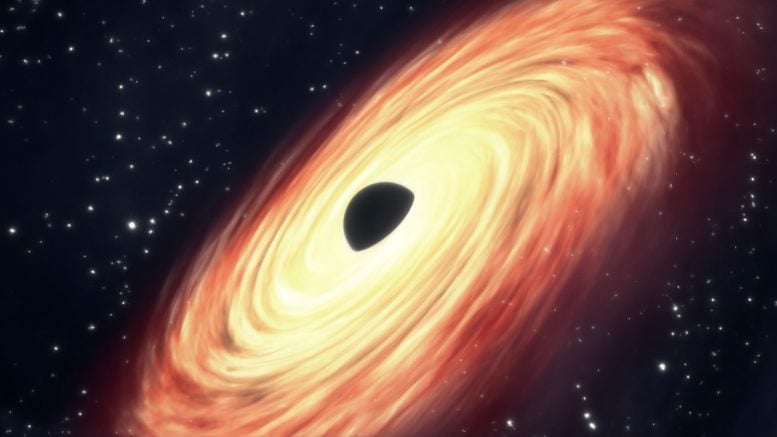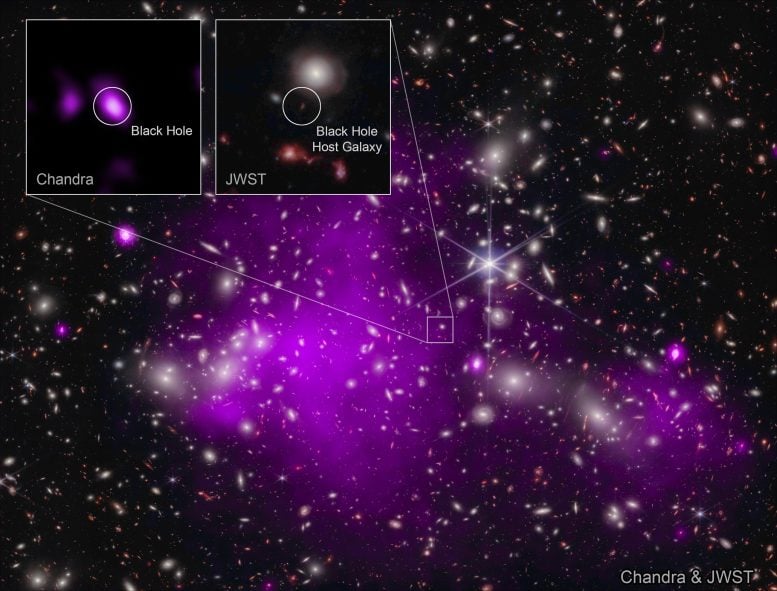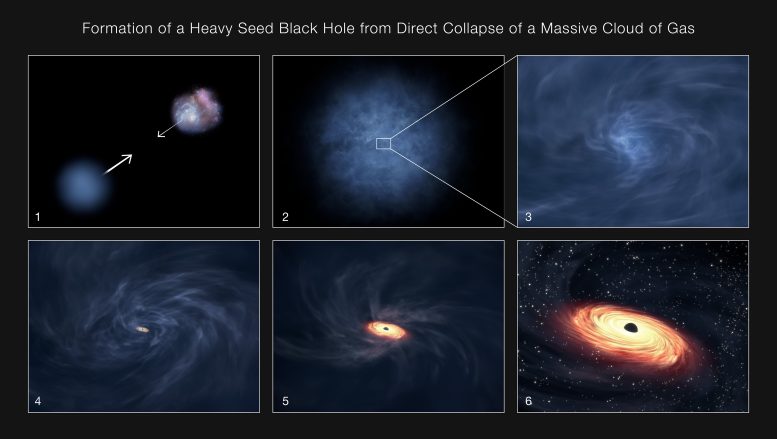
Astronomers have discovered the most distant black hole ever observed in X-rays, located in galaxy UHZ1, over 13 billion light-years away. Using data from the Chandra X-ray Observatory and the James Webb Space Telescope, the findings suggest the black hole was massive at birth, challenging current theories about the early universe’s supermassive black holes. Credit: NASA
- A key indicator of a growing supermassive black hole – X-ray emission – has been found in an extremely distant galaxy.
- This galaxy, UHZ1, is 13.2 billion light-years away, seen when the universe was only 3% of its current age.
- NASA’s Chandra X-ray Observatory and James Webb Space Telescope joined forces to make this discovery.
- This is considered the best evidence to date that some early black holes formed from massive clouds of gas.

Astronomers found the most distant black hole ever detected in X-rays (in a galaxy dubbed UHZ1) using the Chandra and Webb space telescopes. X-ray emission is a telltale signature of a growing supermassive black hole. This result may explain how some of the first supermassive black holes in the universe formed. These images show the galaxy cluster Abell 2744 that UHZ1 is located behind, in X-rays from Chandra and infrared data from Webb, as well as close-ups of the black hole host galaxy UHZ1. Credit: X-ray: NASA/CXC/SAO/Ákos Bogdán; Infrared: NASA/ESA/CSA/STScI; Image Processing: NASA/CXC/SAO/L. Frattare & K. Arcand
NASA Telescopes Discover Record-Breaking Black Hole
This image reveals the most remote black hole ever identified through X-rays, potentially shedding light on the formation of the earliest supermassive black holes in the cosmos. This discovery was made using X-rays from NASA’s Chandra X-ray Observatory (depicted in purple) and infrared data from the James Webb Space Telescope (shown in red, green, blue).
Galactic Distances and Observations
The extremely distant black hole is located in the galaxy UHZ1 in the direction of the galaxy cluster Abell 2744. The galaxy cluster is about 3.5 billion light-years from Earth. Webb data, however, reveal that UHZ1 is much farther away than Abell 2744. At some 13.2 billion light-years away, UHZ1 is seen when the universe was only 3% of its current age.
Gravitational Lensing and X-ray Detection
By using over two weeks of observations from Chandra, researchers were able to detect X-ray emission from UHZ1 — a telltale signature of a growing supermassive black hole in the center of the galaxy. The X-ray signal is extremely faint and Chandra was only able to detect it — even with this long observation — because of the phenomenon known as gravitational lensing that enhanced the signal by a factor of four.
Imaging Techniques and Orientation
The purple parts of the image show X-rays from large amounts of hot gas in Abell 2744. The infrared image shows hundreds of galaxies in the cluster, along with a few foreground stars. The insets zoom into a small area centered on UHZ1. The small object in the Webb image is the distant galaxy UHZ1 and the center of the Chandra image shows X-rays from material close to the supermassive black hole in the middle of UHZ1. The large size of the X-ray source compared to the infrared view of the galaxy is because it represents the smallest size that Chandra can resolve. The X-rays actually come from a region that is much smaller than the galaxy.
Different smoothing was applied to the full-field Chandra image and to the Chandra image in the close-up. Smoothing across many pixels was performed for the large image, to highlight the faint cluster emission, at the expense of not showing faint X-ray point sources like UHZ1. Much less smoothing was applied to the close-up so faint X-ray sources are visible. The image is oriented so that north points 42.5 degrees to the right of vertical.

Illustration: Formation of a Heavy Seed Black Hole from Direct Collapse of a Massive Cloud of Gas. Credit: NASA/STScI/Leah Hustak
Significance of the Discovery
This discovery is important for understanding how some supermassive black holes — those that contain up to billions of solar masses and reside in the centers of galaxies — can reach colossal masses soon after the Big Bang. Do they form directly from the collapse of massive clouds of gas, creating black holes weighing between about ten thousand and a hundred thousand suns? Or do they come from explosions of the first stars that create black holes weighing only between about ten and a hundred suns?
Research Findings and Theoretical Implications
The team of astronomers found strong evidence that the newly discovered black hole in UHZ1 was born massive. They estimate its mass falls between 10 and 100 million suns, based on the brightness and energy of the X-rays. This mass range is similar to that of all the stars in the galaxy where it lives, which is in stark contrast to black holes in the centers of galaxies in the nearby universe that usually contain only about a tenth of a percent of the mass of their host galaxy’s stars.
The large mass of the black hole at a young age, plus the amount of X-rays it produces and the brightness of the galaxy detected by Webb, all agree with theoretical predictions in 2017 for an “Outsize Black Hole” that directly formed from the collapse of a huge cloud of gas.
Ongoing Research and Collaboration
The researchers plan to use this and other results pouring in from Webb and those combining data from other telescopes to fill out a larger picture of the early universe.
The paper describing the results appears in Nature Astronomy. The authors include Akos Bogdan (Center for Astrophysics | Harvard & Smithsonian), Andy Goulding (Princeton University), Priyamvada Natarajan (Yale University), Orsolya Kovacs (Masaryk University, Czech Republic), Grant Tremblay (CfA), Urmila Chadayammuri (CfA), Marta Volonteri (Institut d’Astrophysique de Paris, France), Ralph Kraft (CfA), William Forman (CfA), Christine Jones (CfA), Eugene Churazov (Max Planck Institute for Astrophysics, Germany), and Irina Zhuravleva (University of Chicago).
The Webb data used in both papers is part of a survey called the Ultradeep Nirspec and nirCam ObserVations before the Epoch of Reionization (UNCOVER). The paper led by UNCOVER team member Andy Goulding appears in the Astrophysical Journal Letters. The co-authors include other UNCOVER team members, plus Bogdan and Natarajan. A detailed interpretation paper that compares observed properties of UHZ1 with theoretical models for Outsize Black Hole Galaxies is currently under review and a preprint is available here.
References:
“Evidence for heavy-seed origin of early supermassive black holes from a z ≈ 10 X-ray quasar” by Ákos Bogdán, Andy D. Goulding, Priyamvada Natarajan, Orsolya E. Kovács, Grant R. Tremblay, Urmila Chadayammuri, Marta Volonteri, Ralph P. Kraft, William R. Forman, Christine Jones, Eugene Churazov and Irina Zhuravleva, 6 November 2023, Nature Astronomy.
DOI: 10.1038/s41550-023-02111-9
“UNCOVER: The Growth of the First Massive Black Holes from JWST/NIRSpec—Spectroscopic Redshift Confirmation of an X-Ray Luminous AGN at z = 10.1” by Andy D. Goulding, Jenny E. Greene, David J. Setton, Ivo Labbe, Rachel Bezanson, Tim B. Miller, Hakim Atek, Ákos Bogdán, Gabriel Brammer, Iryna Chemerynska, Sam E. Cutler, Pratika Dayal, Yoshinobu Fudamoto, Seiji Fujimoto, Lukas J. Furtak, Vasily Kokorev, Gourav Khullar, Joel Leja, Danilo Marchesini, Priyamvada Natarajan, Erica Nelson, Pascal A. Oesch, Richard Pan, Casey Papovich, Sedona H. Price, Pieter van Dokkum, Bingjie Wang, 冰洁 王, John R. Weaver, Katherine E. Whitaker and Adi Zitrin, 22 September 2023, The Astrophysical Journal Letters.
DOI: 10.3847/2041-8213/acf7c5
NASA’s Marshall Space Flight Center manages the Chandra program. The Smithsonian Astrophysical Observatory’s Chandra X-ray Center controls science operations from Cambridge, Massachusetts, and flight operations from Burlington, Massachusetts.
The James Webb Space Telescope is the world’s premier space science observatory. Webb will solve mysteries in our solar system, look beyond to distant worlds around other stars, and probe the mysterious structures and origins of our universe and our place in it. Webb is an international program led by NASA with its partners, ESA (European Space Agency) and the Canadian Space Agency.









Fourth, the fourth thing that is very important is the fast rotation of Jupiter around itself and the slower rotation of Mercury and the much slower rotation of Venus, which due to the many collisions of small planets has caused Venus to reverse, it takes 243 days for Venus to rotate around itself. Consider two rear wheels of a truck that are rotating in the same direction, if their distance to each other is reduced and they rub, they will stop and reverse their rotation. Venus reverses, which happened in our solar system. Now in the car’s gearbox, the gears that are on top of each other and are engaged with each other, each of them turns against each other, but they do not stop and cause acceleration and transfer of motion to each other. The star is also opposite to the planet. It always revolves around itself. Well, it is known that when a star collides with a planet, the planet never stops, but its rotation around itself becomes faster. The outer planets of the solar system are Neptune, Uranus, Saturn and Jupiter. Due to the collision of many stars, these four outer planets of the solar system rotate around themselves much faster than the four rocky planets. For the fourth reason that I mentioned, you researchers and scientists must accept that the stars and their planets are from the branch arm of the Milky Way galaxy. They were hitting the objects of the solar system. I didn’t find out about this by chance, and this discovery was due to the efforts of the scientists of NASA, who sent the spacecraft and probes to the planets and the detailed information that they sent to the earth. I was always reading and reviewing and persevering until I realized this complicated secret and I am here thanking the scientists of NASA. I am telling this important thing. The stars of the arm of the Milky Way galaxy were much smaller than the Sun when they came to our solar system. The planets of that star were also small, and now most of them have joined the moons of the outer and inner planets, even the Earth, Mars, Venus, and Mercury were the planets of the Milky Way stars, which joined the side and side of our Sun with the stars of the Milky Way galaxy several billion years ago, without exception, all the 234 moons of the system The Suns themselves were the planets that joined the rotation of the planets of the solar system from the two arms of the Milky Way. Continue this very important article in the coming days. If the Islamic Republic does not filter this site, I will send you this site, Dr. Mehrdad from Iran, may God protect you, astronomers. After rechecking the ones I translate, if I find spelling and composition mistakes, I correct them, that’s why I get into trouble, and words and sentences may be moved back and forth, but I’m not to blame. This problem is due to the regime’s filtering of sites. The dictator of the Islamic Republic is Zeddin nomber mobil mehrdad aghakasiri monajim iran 00989332197646
I re-reviewed the article that I sent a couple of hours ago, and I realized that the Hashmand Translate software is for translation, and I use it to spell and compose dictation of words and sentences that have been moved, reversed, forwarded, and some words and sentences. It has been deleted and disappeared, so I am sending it again to the managers of the interesting scitech daily site, which is about the moons of the solar system. I said in the previous text that all the rocky planets and the moons next to the planets of the solar system were originally planets themselves, which are from the two big arms of the galaxy towards Our sun came along with their stars, the stars and their number was about 400 planets and stars that came to the sun in a period of several billion years until now, out of these 400 planets that came to the solar system objects, 162 planets to Neptune, Uranus, Saturn and Jupiter and percent Some of them hit the sun and the planets Venus and Mercury. Those that hit the sun did not remain intact. The 238 planets that remained intact turned into 234 moons and 4 rocky planets, like Mars, Earth, Venus and Mercury, and their stars, along with those 400 planets, became They came towards the sun, most of those stars collided with gas planets, that’s why these four outer planets of the solar system are called gas giant planets. Hydrogen gas inside Neptune, Uranus, Saturn and Jupiter is a definite hundred of very small stars that were formed due to the collision of dozens of stars with Jupiter. Jupiter and Jupiter are still burning due to the collision of dozens of small stars, and the iron on the surface of the planet Jupiter is moving and flowing like rivers on the surface of the planet Jupiter. They were from the sun, when they hit the surface of Jupiter violently, they caused Jupiter to rotate at a speed of more than 45,000 km per hour, the earth rotates at a speed of nearly 1,700 km per hour in 24 hours, but Jupiter, which is 778 million from the sun, km away, it must rotate slower than the earth. I explained the reason for this important issue in the previous comments to you scholars and astronomy enthusiasts. Whenever the stars collide with the planets, they make the planet spin faster and faster, and I gave you the example of a car gear. The gears that cause the movement in the wheels to be placed on top of each other are opposite to each other, but they cause the wheels to rotate. The sun also turns against the planet when it hits the surface of a planet like Jupiter, it transfers its inertial and rotational force to the planet, and this is a problem in The case of Jupiter has happened many times, and for this reason, the speed of Jupiter’s rotation around itself has become faster and faster due to the impact of dozens of stars, but don’t think that I achieved this very, very important secret in a short time. It took tens of years for me to solve this very important issue. It reveals other secrets related to the impact of meteorites on the earth, the moon, the planets and the objects of the solar system. Be loved. mehrdad aghakasiri iran
I don’t see the use of relating conspiracy theory – some about the entirely natural process of big bang space expansion that shows religious magic is not a significant (if at all) part of the universe.
Finally, independent of your personal opinion, which you can express freely in free nations, I hope you can continue to do so.
The early universe was an unruly place:
“(iv) the extended JWST morphology of UHZ1 that is suggestive of a recent merger, which is also a predicted property for the formation of transient OBGs.”
From another recent paper:
“We suspect that gas cooling induced by strong interactions and/or major mergers could be triggering the extreme emission lines, and the increased merger rate might be responsible for the over-abundance of EELGs at z > 6.” [“MOSEL survey: JWST reveals major mergers/strong interactions drive the extreme emission lines in the early universe”,
Anshu Gupta et al., via Ken Turner, Live Science.]
Hello
I am an experimental astronomer and the opinions I gave about the structure of the solar system are very accurate and compatible with reason and logic. Unfortunately, because over the course of billions of years the two large arms of the Milky Way have changed thousands of times, the stars and planets of these two large arms of the Milky Way have Solar objects collided. Some astronomers believe that there was a big bang and a big explosion that left all the traces of collisions on solar objects. Lions, which form many smaller systems than the solar system, collided with the sun and solar bodies, and for this reason, some astronomers think that an initial explosion took place, which they called the Big Bang theory, which has no foundation, but The theory we mentioned has a foundation and is based on logic and reason doctor mehrdadshmiranat